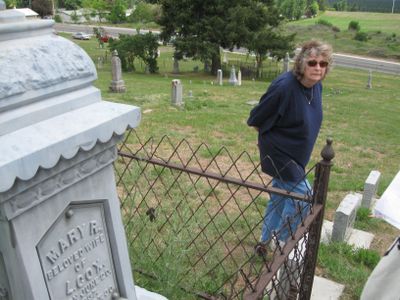Tombstones an index of region’s rich history
Cemetery tour provides glimpse of Cheney’s past

Cheney couldn’t be a city until it had a cemetery, so in 1881 land was given for a burial ground. The stories of the people who are buried there are the stories of the history of Cheney.
Helen Boots, Cheney Cemetery Association historian, decided that a walking tour of some of Fairview Cemetery’s earliest residents would generate an interest in the association.
Boots told visitors last Saturday that she had gathered the information on her historical tour from newspaper accounts – the Northwest Tribune, The Spokesman-Review and the Cheney Free Press – and purposefully omitted the stories her grandmother used to tell her.
“So many people who were so important in state, county and local government (are here),” Boots said.
The land used to be part of an orchard before it became a cemetery and there are still plum trees from the orchard living in the cemetery today. Four of the six acres of Fairview were donated to the city, and the city paid for the other two acres.
Boots led the group to different lichen-covered headstones and explained the history of the families – some of the stories were humorous and some were very sad.
She described the history of the Cox family as one filled with “love, mystery and murder.”
The first Mrs. Cox died in 1905. Her husband quickly hired a housekeeper and shortly after that, married her. It really wasn’t a happy union. Boots said that once, the husband became ill. While he was sick, his new wife sold part of his land. The couple later moved to Seattle and had a reputation for having volatile arguments.
“They had disagreements,” Boots said. “She also consumed quite heavily on brandy.”
One night, the two had an argument while in their front yard. They both ended up being shot in the head twice each. He survived. He originally pleaded guilty, but later changed his mind and he was acquitted.
Boots also pointed out the headstone of the first person to be buried in the cemetery in 1881.
Samuel Hammer came out West in 1880. In 1881 he decided to bathe himself in Clear Lake and drowned.
She pointed out a group of stones that aren’t marked and haven’t weathered time as well as the others. Boots said that at one point, the cemetery was burned to get rid of weeds and the stones survived. Of course, no one kept very good records back then, so they don’t know who is buried under those stones.
Boots also explained the story behind the street names in the cemetery. When the cemetery was first platted, the aisles between the family plots were given names. A few years ago, someone put up the street signs as part of an Eagle Scout project.
For almost two hours, Boots led the small group of people around the cemetery, telling stories of covered wagons and Civil War heroes.
She said she isn’t sure when she’s going to have another walking tour of Fairview, but hopes to have one soon.
“Every single one of these stones has a story behind it,” Boots said.